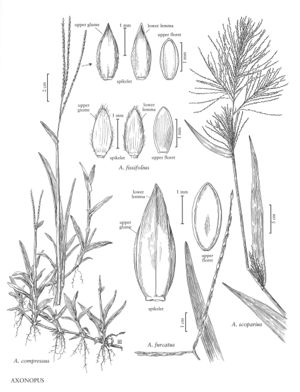Axonopus furcatus
Plants stoloniferous. Culms 30-100 cm; nodes glabrous or pubescent. Sheaths compressed, glabrous or sparsely to densely pilose, hairs appressed; ligules 0.3-1 mm; blades 3-25 cm long, 2-15 mm wide, margins often with papillose-based hairs near the base, scabrous distally. Panicles terminal and axillary, with 2 (-4) divergent branches; branches 4-15 cm. Spikelets 3.5-5.5 mm long, about 1.5 mm wide, sessile or subsessile, ovoid-ellipsoid, acuminate. Upper glumes glabrous, 5-7-veined; lower lemmas 5-7-veined, glabrous or sparsely pilose over the veins; upper lemmas and paleas 2.5-3.2 mm, light yellow, obtuse. Caryopses 1.8-2.2 mm, obovate, yellow. 2n = unknown.
Distribution
Md., Del., Miss., Tex., La., Ala., N.C., S.C., Va., Ark., Ga., Okla., Fla.
Discussion
Axonopus furcatus is endemic to the southeastern United States. It grows in moist pine barrens, marshes, river banks, wet ditches, pond margins, and other such damp areas.
Selected References
None.
